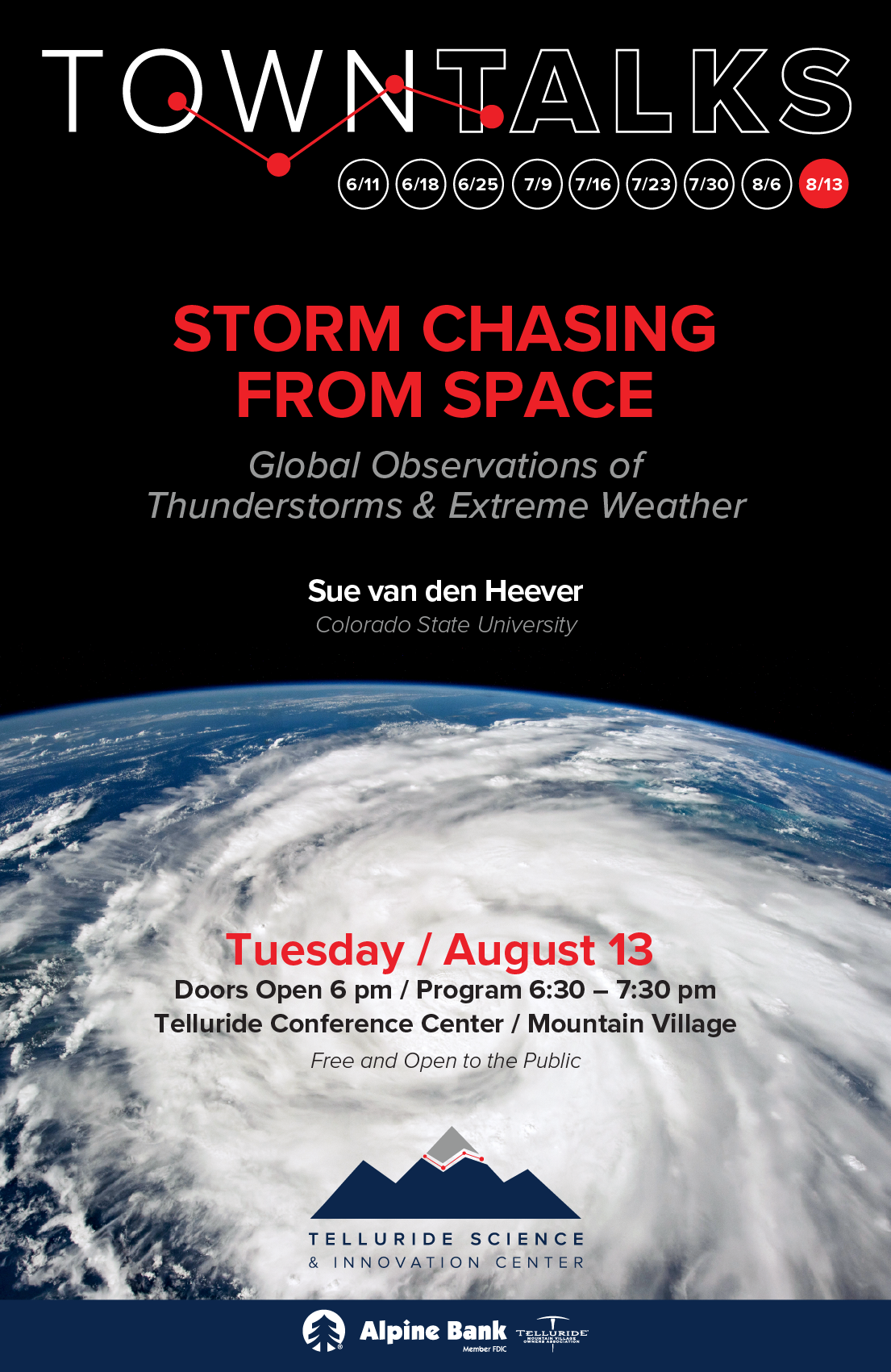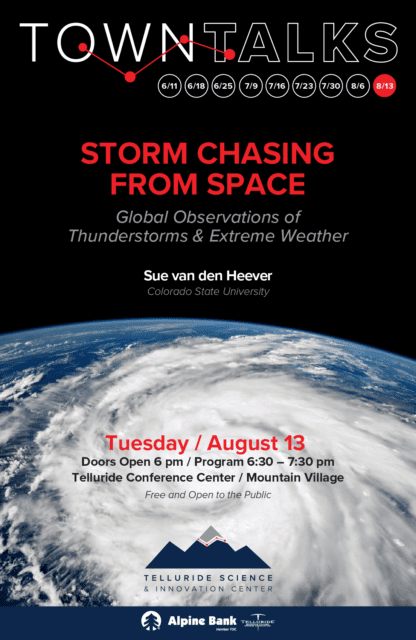
06 Aug Telluride Science Town Talks: “Observing Thunderstorms & Extreme Weather from Space” 8/13!
This coming week the 2024 Telluride Science Town Talks series continues with “Observing Thunderstorms & Extreme Weather from Space” with Dr. Sue van den Heever. The event takes place Tuesday, August 13, 6:30 pm, doors, 6 p.m., at the Telluride Conference Center in Mountain Village. Town Talks are FREE and open to the public.
Visit telluridescience.org to learn more about Telluride Science and the capital campaign to transform the historic Telluride Depot into the Telluride Science & Innovation Center. The venue is now the permanent home for Telluride Science and a global hub of inspired knowledge exchange and development where great minds get to solve great challenges.
The 2024 Telluride Science Town Talks series has been presented by Alpine Bank with additional support from the Telluride Mountain Village Owner’s Association.
Go here for more about Telluride Science.
Go here for more on Town Talks.

According to New York’s American Museum of Natural History, rainstorms help sustain life on Earth by bringing much needed water. But there’s a big difference between a restorative shower and an intense downpour that causes floods and landslides.
By the numbers, Planet Earth experiences a staggering 16 million thunderstorms and hurricanes each year. But what’s new is the intensity of those storms such as the recent Debby.
And that sobering news has everything to do with global warming.
As our planet continues to warm, intense and destructive storms are likely to become more and more frequent over many land regions. In fact, as we pointed out, they already have.
At the final Telluride Science Town Talk, August 13, an expert on severe weather, Dr. Susan van den Heever is presenting “Storm Chasing from Space, Global Observations of Thunderstorms and Extreme Weather.”
“Life on Earth is fundamentally impacted by thunderstorms, from the life-sustaining freshwater they supply, to the life-threatening severe weather they produce. Thunderstorms also play a critical role in driving large-scale atmospheric circulations thereby establishing regional climates. In addition, the high clouds produced by thunderstorms play a critical role in modulating atmospheric temperatures.”
Bottom line: thunderstorms are invaluable in regulating Earth’s atmosphere and climate. The consistent patterns of these storms dictate which geographical regions receive rainfall, creating lush rainforests in some areas – and arid deserts in others. They also act as insulation that can both warm the atmosphere by trapping heat or cool the atmosphere by reflecting radiation from the sun.
Van den Heever is especially concerned with the effects of global warming on thunderstorms as suggested above. With higher temperatures, the convective currents that power thunderstorms become stronger, creating climate events of increased intensity and hazard. And, with the increasing danger of thunderstorms, it becomes more and more important for scientists to accurately predict when such happenings will occur. Correctly forecasting thunderstorms can save lives, however, doing so is not easy as it might seem.
“Accurately predicting thunderstorms and extreme weather using our current numerical prediction models remains extremely challenging. We need global observations of thunderstorms if we are to address such challenges,” Van den Heever adds.
Van den Heever’s solution? Observing storms from space.
Van den Heever heads a NASA Earth Ventures mission designed to deploy satellites for that very purpose. Her mission will allow scientists to better understand the formation of convective storms in order to more accurately predict severe weather and, ultimately, save human lives.
Susan van den Heever, more:

Dr. Susan van den Heever, courtesy Telluride Science.
Born in South Africa, Susan van den Heever attended the University of Witwatersrand where she earned a Master of Science in Physical
Geography.
She then moved to the United States where she carried out her doctoral research at Colorado State University, earning a PhD in Atmospheric Science.
In 2021, van den Heever was named a Fellow of the American Meteorological Society.
Van den Heever was nominated to be the first woman to lead a NASA Earth Ventures mission (INCUS) where she is committed to understanding the formation of convective storms and the extreme weather they can produce.


Sorry, the comment form is closed at this time.